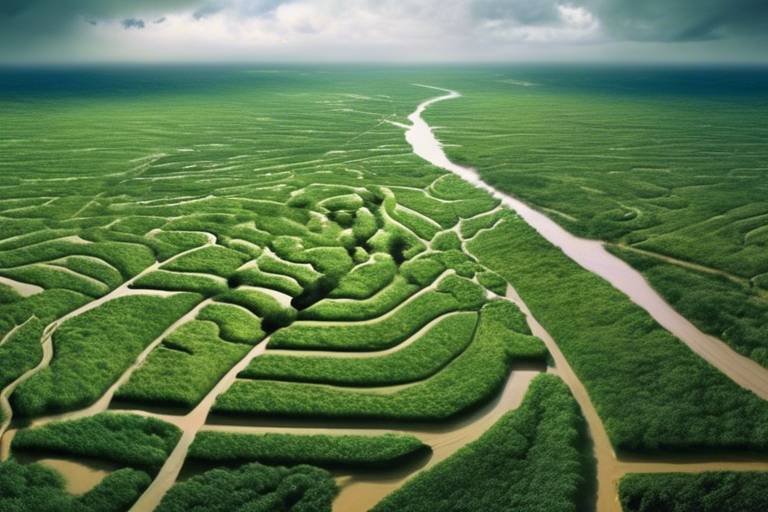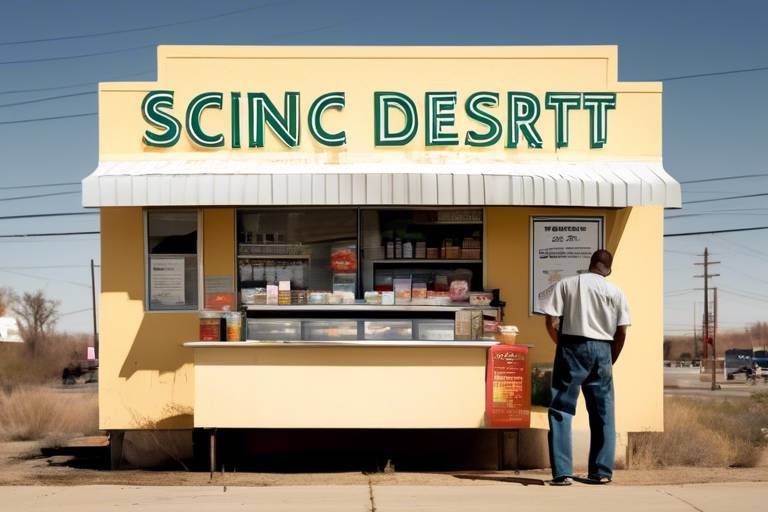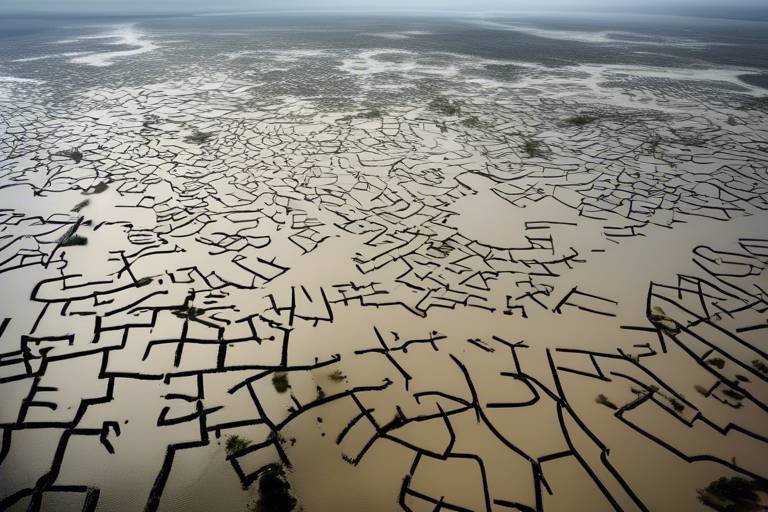The Latest Findings on the Effects of Urbanization on Biodiversity
Urbanization is like a double-edged sword; it brings about economic growth and development, yet it also poses a significant threat to biodiversity. As cities expand, they consume vast tracts of land, transforming lush landscapes into concrete jungles. Recent studies have shed light on the complex relationship between urbanization and biodiversity, revealing that while some species adapt to urban environments, many others face dire consequences. The interplay between human activities and natural ecosystems is intricate, and understanding this dynamic is crucial for preserving our planet's biological richness.
One of the most alarming findings is the rapid rate of habitat loss due to urban sprawl. When forests, wetlands, and grasslands are replaced by roads, buildings, and other infrastructures, the native flora and fauna that once thrived in these areas are often displaced. This phenomenon not only leads to a decrease in species diversity but also disrupts the ecological processes that sustain life. For instance, pollinators like bees and butterflies, which are vital for plant reproduction, find it increasingly difficult to navigate fragmented landscapes. This raises the question: how can we balance urban development with the need to protect our natural heritage?
Moreover, urban areas often experience a shift in species composition. Some wildlife, such as raccoons, pigeons, and coyotes, have adapted remarkably well to urban settings, exploiting new food sources and nesting sites. However, this adaptation comes at a cost. The dominance of these adaptable species can lead to a decline in more sensitive native species, creating an imbalance that can ripple through the ecosystem. Recent research indicates that cities can act as both a refuge and a trap for wildlife, depending on various factors such as habitat quality, availability of resources, and human-wildlife interactions.
To truly grasp the effects of urbanization on biodiversity, we must also consider the implications for ecosystem services. Healthy ecosystems provide us with clean air, water, and food, among other benefits. When urbanization disrupts these systems, we risk losing the very resources we depend on. For instance, wetlands that filter pollutants are often drained for development, leading to increased water pollution and flooding. This highlights the urgent need for sustainable urban planning that incorporates green spaces and preserves natural habitats.
In conclusion, the latest findings on urbanization reveal a complex web of interactions that significantly impact biodiversity. While urban areas can support certain species, they also pose challenges that can lead to declines in native populations and disrupt essential ecosystem services. It's imperative that we rethink our approach to urban development, considering not just the immediate benefits but also the long-term consequences for our planet's biodiversity. By fostering a deeper understanding of these issues, we can work towards creating urban environments that coexist harmoniously with nature.
- What is urbanization? Urbanization is the process by which rural areas are transformed into urban areas, typically involving an increase in population density and infrastructure development.
- How does urbanization affect wildlife? Urbanization leads to habitat loss and fragmentation, which can negatively impact wildlife populations by reducing their living space and food sources.
- What are invasive species? Invasive species are non-native organisms that, when introduced to a new environment, can outcompete native species for resources and disrupt local ecosystems.
- Why are urban green spaces important? Urban green spaces, such as parks and gardens, provide habitats for wildlife, improve air quality, and enhance the overall well-being of urban residents.
- How can communities help protect biodiversity? Community involvement in conservation efforts, such as participating in local clean-up events or supporting native plant initiatives, plays a crucial role in protecting biodiversity.

The Impact of Urbanization on Wildlife
This article explores how urbanization impacts biodiversity, highlighting recent research findings, discussing the consequences for ecosystems, and suggesting strategies for mitigating negative effects on wildlife and plant species.
Urbanization is reshaping our landscapes in ways that are both fascinating and alarming. As cities expand, they transform natural habitats into bustling environments filled with concrete, steel, and human activity. This transformation leads to significant habitat loss and fragmentation, which can have dire consequences for wildlife. Imagine a once-thriving forest, now reduced to isolated patches surrounded by roads and buildings. This not only limits the space available for animals to roam but also disrupts their migratory patterns and feeding behaviors.
When we talk about the impact of urbanization on wildlife, we must consider the various species that inhabit these altered landscapes. For instance, many birds that once thrived in open fields or dense forests find it increasingly challenging to adapt to urban environments. The noise, pollution, and lack of suitable nesting sites can lead to decreased populations. Moreover, some species may even change their behaviors—becoming more nocturnal to avoid human interactions or altering their diets to include more human refuse. This shift can have cascading effects on the ecosystem, as these animals play critical roles in pest control, pollination, and seed dispersal.
Furthermore, urbanization can create barriers that prevent wildlife from accessing essential resources. For example, roads can act as deadly obstacles, leading to increased roadkill incidents, particularly for smaller mammals and reptiles. The fragmentation of habitats can isolate populations, making it harder for them to breed and thrive. In this context, urban areas become ecological traps, where wildlife struggles to survive despite the presence of resources that might otherwise support them.
Interestingly, while urbanization poses significant challenges, it can also create unique opportunities for certain species. Some animals, like raccoons and pigeons, have adapted remarkably well to urban life. They have learned to exploit human waste and find shelter in buildings. However, this adaptability often comes at a cost—these species can outcompete native wildlife, leading to declines in biodiversity. This phenomenon raises an important question: at what point does urban wildlife become a threat to the very ecosystems we seek to protect?
To better understand these impacts, researchers have been studying urban wildlife populations and their interactions with the environment. Recent studies have shown that urban areas can support diverse species, but the overall health of these populations is often compromised. Long-term exposure to urban stressors can lead to reduced genetic diversity and increased vulnerability to disease. This brings us back to the importance of creating sustainable urban spaces that not only accommodate human needs but also promote wildlife health.
In conclusion, the impact of urbanization on wildlife is a complex interplay of challenges and adaptations. While some species may thrive in urban settings, the overall trend points toward a decline in biodiversity. To mitigate these effects, it is crucial to rethink urban planning and development strategies. By incorporating green spaces, wildlife corridors, and native vegetation into city designs, we can foster environments where both humans and wildlife can coexist harmoniously.
- How does urbanization affect local wildlife?
Urbanization leads to habitat loss, fragmentation, and changes in animal behavior, which can threaten local wildlife populations. - Are there any species that benefit from urbanization?
Yes, some species like raccoons and pigeons have adapted well to urban environments, often thriving on human resources. - What can be done to protect wildlife in urban areas?
Creating green spaces, wildlife corridors, and promoting native plant species can help support biodiversity in cities.

Changes in Plant Diversity
Urbanization is like a double-edged sword when it comes to plant diversity. On one hand, cities are bustling with life and innovation, but on the other hand, they carve up natural habitats and alter ecosystems in ways that can be detrimental to native plant species. As urban areas expand, we often see a significant shift in the types of plants that thrive. This is primarily due to human activities that favor certain species while pushing others to the brink of extinction.
One of the most profound impacts of urbanization on plant diversity is the replacement of native flora with non-native species. These non-native plants, often introduced for ornamental purposes or landscaping, can outcompete local species for resources like sunlight, water, and nutrients. Over time, this leads to a decline in the population of native plants, which are crucial for maintaining the ecological balance. For example, the introduction of species like Japanese knotweed or English ivy can create a monoculture, where a single species dominates the landscape, leaving little room for the diverse array of plants that once flourished.
Moreover, urban environments often lack the conditions necessary for many native plants to thrive. Factors such as soil compaction, pollution, and altered water drainage patterns can create a hostile environment for local flora. This is particularly concerning because native plants play vital roles in their ecosystems, providing habitat and food for various wildlife species. Without these plants, the entire urban ecosystem can suffer, leading to a domino effect that impacts everything from pollinators to larger herbivores.
Interestingly, some studies have shown that urban areas can also foster unique plant communities. For instance, green roofs and vertical gardens have emerged as innovative solutions that not only beautify urban spaces but also help preserve biodiversity. These green spaces can support a surprising variety of plant species, including some that are native to the region. In fact, urban green spaces can serve as important refuges for plants that are otherwise struggling in the wild.
In addition to the direct impacts of urbanization, the way we manage our green spaces also plays a crucial role in plant diversity. For example, landscaping practices that prioritize native plants over non-natives can significantly enhance biodiversity. Community gardens and urban farms can also contribute to the preservation of plant diversity by providing spaces where native species can flourish and be cultivated. By engaging local residents in these initiatives, we can foster a greater appreciation for the importance of plant diversity in urban settings.
In conclusion, the changes in plant diversity due to urbanization are complex and multifaceted. While urban areas can pose significant challenges for native plants, they also present opportunities for innovation and conservation. By understanding these dynamics and actively working to promote native species, we can create urban environments that not only support human life but also nurture the rich tapestry of plant diversity that is essential for a healthy ecosystem.
- What are the main factors affecting plant diversity in urban areas?
Urbanization leads to habitat destruction, pollution, and the introduction of non-native species, all of which can negatively impact native plant diversity. - How can urban green spaces benefit plant diversity?
Green spaces like parks, gardens, and green roofs can provide habitats for native species and promote biodiversity in urban environments. - What role do community gardens play in preserving plant diversity?
Community gardens can cultivate native plants and educate residents about the importance of biodiversity, creating a connection between people and nature.

Invasive Species Proliferation
Urbanization is a double-edged sword; while it brings economic development and improved living standards, it also acts as a catalyst for the proliferation of invasive species. These non-native organisms thrive in urban environments, often due to the unique conditions created by human activities. For instance, the alteration of landscapes through construction and landscaping introduces new niches that invasive species eagerly exploit. Think of it like a party where uninvited guests show up, taking over the best spots and leaving the original occupants feeling out of place.
In urban areas, the lack of natural predators and the availability of resources can give invasive species a competitive edge over native flora and fauna. This phenomenon is particularly alarming because invasive species can disrupt local ecosystems, leading to a cascade of negative effects. For example, species such as the Japanese Knotweed and Common Buckthorn can outcompete native plants for sunlight, water, and nutrients, ultimately leading to a decline in biodiversity. The consequences extend beyond just plant life; wildlife that relies on native plants for food and habitat may also suffer.
The spread of invasive species is not just a local issue; it can have far-reaching implications. Urban centers often serve as hubs for transportation and trade, inadvertently facilitating the introduction of these species to new areas. A study by the National Wildlife Federation found that over 50% of invasive species in the United States have been linked to human activity, particularly in urban settings. This alarming statistic underscores the need for effective management strategies to combat the spread of invasive species.
To better understand the impact of invasive species, consider the following table, which outlines some common invasive species found in urban areas and their effects on native ecosystems:
| Invasive Species | Origin | Impact on Native Species |
|---|---|---|
| Japanese Knotweed | Asia | Outcompetes native plants, disrupts soil stability |
| Common Buckthorn | Europe | Reduces biodiversity, alters habitat for birds |
| English Ivy | Europe | Covers and kills native trees, reduces light for understory plants |
The urgency to address the proliferation of invasive species in urban environments cannot be overstated. By understanding their pathways of introduction and the conditions that favor their establishment, we can develop targeted strategies to mitigate their impact. This includes public education on identifying invasive species, community monitoring programs, and the implementation of policies aimed at controlling their spread. After all, preserving the delicate balance of urban ecosystems is not just beneficial for wildlife; it enhances the quality of life for all urban residents.
In conclusion, the proliferation of invasive species in urban settings is a pressing concern that requires immediate attention. By recognizing the challenges they pose and actively engaging in management efforts, we can help safeguard our native biodiversity and ensure that our urban spaces remain vibrant and healthy for generations to come.

Effects on Native Species
Urbanization has a profound impact on native species, often leading to their decline and even extinction in certain areas. As cities expand, natural habitats are replaced with concrete jungles, drastically altering the ecosystems that many native species rely on for survival. One of the most significant effects is the competition for resources. Invasive species, which thrive in disturbed environments, often outcompete native flora and fauna for food, space, and light. For instance, the introduction of non-native plants can overshadow native plants, effectively blocking sunlight and nutrients, which are crucial for their growth.
Moreover, the changes in land use and habitat fragmentation disrupt the natural behaviors of native species. Many animals depend on large territories for hunting, mating, and migration. However, urban landscapes often create isolated patches of habitat, making it difficult for these species to thrive. Fragmentation can lead to a phenomenon known as the “edge effect,” where the conditions at the boundaries of these patches differ significantly from the interior, often exposing native species to increased predation and competition.
Additionally, urban areas can introduce new threats such as pollution and human-wildlife conflict. For example, birds that once thrived in open fields may find it challenging to adapt to urban noise and light pollution, which can disrupt their mating calls and navigation. Similarly, mammals like raccoons and foxes may venture into urban areas in search of food, leading to increased encounters with humans, which can result in negative outcomes for both parties.
To illustrate the impact of urbanization on native species, consider the following table that highlights some common native species and their corresponding challenges in urban environments:
| Native Species | Challenges Faced |
|---|---|
| Eastern Bluebird | Habitat loss and competition from invasive species like House Sparrows. |
| Red Fox | Human-wildlife conflict and habitat fragmentation. |
| Native Wildflowers | Competition from invasive plant species and soil degradation. |
In summary, the effects of urbanization on native species are multifaceted and often detrimental. As urban areas continue to grow, it is essential to recognize the value of preserving native biodiversity. Not only do these species contribute to the ecological balance, but they also enhance our urban environments, making them more vibrant and resilient. Protecting native species should be a priority for urban planners and policymakers, ensuring that we maintain a healthy coexistence with the natural world.
- What are invasive species?
Invasive species are non-native organisms that can cause harm to the environment, economy, or human health. They often thrive in new habitats, outcompeting native species for resources. - How does urbanization affect local ecosystems?
Urbanization leads to habitat loss, fragmentation, and pollution, which can disrupt local ecosystems and threaten biodiversity. - What can be done to protect native species in urban areas?
Conservation efforts such as creating green spaces, restoring habitats, and implementing community awareness programs can help protect native species.

Management Strategies for Invasive Species
Managing invasive species in urban areas is crucial for preserving biodiversity and maintaining healthy ecosystems. As these non-native species often thrive in disturbed environments, urban settings can become hotspots for their proliferation. However, there are effective strategies that can be employed to mitigate their impact and protect native flora and fauna.
One of the most effective management strategies is the implementation of prevention measures. This involves educating the public about the risks associated with introducing non-native species into local ecosystems. For instance, community workshops can teach residents about the importance of using native plants in landscaping, which not only enhances local biodiversity but also reduces the likelihood of invasive species taking root. Additionally, regulations can be enforced to restrict the sale and distribution of known invasive species in nurseries and garden centers.
Another approach is the use of mechanical control methods. This can include physical removal of invasive plants and the establishment of barriers to prevent their spread. For example, volunteers can participate in community clean-up days to remove invasive species from parks and natural areas. Such hands-on initiatives not only help in controlling invasive populations but also foster a sense of community and stewardship among residents.
Chemical control is another strategy that may be employed, although it should be used with caution. The application of herbicides or pesticides can be effective in managing invasive species, but it is essential to consider the potential impacts on native species and the surrounding environment. Therefore, integrating chemical methods with other strategies, such as biological control, can yield better results. Biological control involves the introduction of natural predators or diseases that specifically target invasive species without harming native populations.
Monitoring and research are also vital components of effective management. By continuously assessing the spread and impact of invasive species, urban planners and conservationists can adapt their strategies based on the latest findings. Collaborating with local universities and research institutions can provide valuable data and insights, ensuring that management efforts are informed and effective.
In conclusion, a multifaceted approach that combines prevention, mechanical removal, chemical control, and ongoing research is essential for managing invasive species in urban environments. By engaging the community and fostering a culture of conservation, we can significantly mitigate the negative impacts of these invaders and protect our precious native biodiversity.
- What are invasive species? Invasive species are non-native organisms that can cause harm to local ecosystems, economies, or human health.
- How do invasive species affect biodiversity? They can outcompete native species for resources, leading to declines in native populations and altering ecosystem dynamics.
- What can I do to help manage invasive species in my area? You can educate yourself and others about invasive species, participate in local clean-up efforts, and choose native plants for your garden.
- Are there any laws regulating the introduction of invasive species? Yes, many regions have regulations in place to control the sale and distribution of known invasive species.

Urban Green Spaces and Biodiversity
Urban green spaces, such as parks, gardens, and green roofs, serve as crucial lifelines for biodiversity in bustling metropolitan areas. In a world where concrete jungles are rapidly expanding, these patches of greenery become sanctuaries for various forms of life. Imagine a small oasis in the middle of a desert; that’s what urban green spaces represent for wildlife. They not only provide essential habitats for birds, insects, and small mammals but also play a vital role in maintaining ecological balance.
One of the key benefits of urban green spaces is their ability to enhance habitat connectivity. By linking fragmented habitats, these green areas allow species to move freely, forage for food, and find mates, which is essential for their survival. For instance, a well-planned urban park can connect various wildlife corridors, enabling creatures like squirrels and birds to thrive even in densely populated areas. This connectivity is crucial, as it mitigates the adverse effects of urbanization, which often leads to isolated populations that struggle to survive.
Moreover, urban green spaces contribute significantly to ecosystem services. They help in air purification, temperature regulation, and stormwater management. Trees and plants absorb carbon dioxide and release oxygen, improving air quality. They also provide shade, which can lower urban temperatures, creating a more comfortable environment for residents and wildlife alike. Furthermore, these green areas can absorb rainwater, reducing flooding and promoting groundwater recharge. It's like having nature's own air conditioning system right in our backyards!
However, the benefits of urban green spaces extend beyond just environmental aspects. They also foster human well-being. Studies have shown that spending time in green areas can reduce stress, improve mental health, and encourage physical activity. This connection between humans and nature is vital for fostering a sense of community and promoting environmental stewardship. When people engage with their local green spaces, they are more likely to appreciate and protect the biodiversity within them.
Despite their importance, urban green spaces face numerous challenges. Urbanization often leads to the degradation of these areas, threatening the biodiversity they support. Factors such as pollution, invasive species, and human encroachment can diminish their effectiveness as habitats. Therefore, it is essential for urban planners and local governments to prioritize the creation and maintenance of these green spaces. Implementing strategies such as native plant landscaping and sustainable management practices can help preserve the ecological integrity of urban green spaces.
In conclusion, urban green spaces are not just aesthetic features of a city; they are vital ecosystems that support biodiversity and contribute to the overall health of urban environments. By recognizing their importance and actively working to protect and enhance these areas, we can ensure that urban wildlife continues to thrive amidst our bustling cities. After all, a city that supports biodiversity is a city that is truly alive!
- What are urban green spaces? Urban green spaces refer to parks, gardens, green roofs, and any other areas covered with vegetation within urban environments.
- Why are urban green spaces important for biodiversity? They provide essential habitats for wildlife, enhance ecosystem services, and promote human well-being.
- How can we improve urban green spaces? By incorporating native plants, ensuring habitat connectivity, and implementing sustainable management practices.
- What role do residents play in conserving urban green spaces? Community involvement is crucial; residents can participate in conservation initiatives, volunteer for maintenance, and advocate for green space preservation.

Human Attitudes and Biodiversity Conservation
When it comes to biodiversity conservation, human attitudes play a pivotal role. Our perceptions, beliefs, and behaviors towards the natural world can significantly influence conservation efforts. In urban environments, where the hustle and bustle often drown out the whispers of nature, understanding these attitudes becomes even more crucial. Have you ever stopped to think about how your daily choices might impact local wildlife? It's a question worth pondering, as even small actions can lead to significant changes.
Research has shown that urban residents generally hold a mix of positive and negative views towards biodiversity. On one hand, many people appreciate the beauty and benefits of green spaces; they recognize that parks, gardens, and trees contribute to their quality of life. On the other hand, there's often a disconnect when it comes to understanding the importance of preserving native species and ecosystems. This disconnect can lead to a lack of support for conservation initiatives. To bridge this gap, it’s essential to foster a deeper connection between urban dwellers and their natural surroundings.
One effective way to enhance public perception is through education and awareness programs. These initiatives can inform residents about the significance of biodiversity and the role they play in its conservation. For instance, community workshops can highlight how urban gardens not only beautify neighborhoods but also provide habitats for pollinators and other wildlife. Imagine transforming a concrete jungle into a vibrant ecosystem where flora and fauna thrive! This vision is achievable if we can shift attitudes towards a more conservation-minded perspective.
Moreover, community involvement is vital in making a lasting impact. When individuals feel a sense of ownership and responsibility for their local environment, they are more likely to engage in conservation efforts. Grassroots initiatives, such as neighborhood clean-up events or tree-planting days, can foster a collective spirit of stewardship. By participating in these activities, residents not only contribute to their local ecosystems but also develop a stronger bond with nature. It’s like planting a seed of awareness that can grow into a flourishing movement for biodiversity conservation.
In summary, the relationship between human attitudes and biodiversity conservation is complex but essential. By enhancing public education and fostering community involvement, we can create a more supportive environment for conservation efforts in urban areas. The journey towards preserving biodiversity starts with us, the urban dwellers. So, next time you stroll through a park or tend to a garden, remember: your actions matter, and together, we can make a difference.
- Why is human attitude important for biodiversity conservation?
Human attitudes shape behaviors and decisions that directly affect conservation efforts. Positive attitudes can lead to increased support for initiatives aimed at preserving biodiversity. - How can I get involved in local conservation efforts?
Look for community organizations or events focused on conservation. Participating in local clean-ups, planting trees, or volunteering at wildlife reserves are great ways to contribute. - What role does education play in biodiversity conservation?
Education raises awareness about the importance of biodiversity, helping individuals understand their impact on the environment and encouraging them to take action.

Education and Awareness Programs
Education and awareness programs are pivotal in cultivating a culture of conservation among urban residents. These initiatives are designed to bridge the gap between knowledge and action, empowering individuals to appreciate and protect the rich biodiversity that exists within their city limits. Imagine walking through a park and suddenly realizing that the trees surrounding you are not just mere decorations but vital components of an intricate ecosystem. This realization can spark a profound connection to nature, motivating people to engage in conservation efforts.
One of the most effective ways to promote awareness is through interactive workshops and community events. These programs often include hands-on activities, such as planting native species or creating habitats for local wildlife. By actively participating, individuals not only learn about biodiversity but also develop a sense of ownership over their environment. For instance, a local gardening club might host a workshop on the importance of native plants, highlighting how they support local pollinators like bees and butterflies. This kind of engagement can turn passive observers into passionate advocates for biodiversity.
Moreover, schools play a crucial role in fostering a conservation mindset among younger generations. Integrating biodiversity topics into the curriculum can ignite curiosity and inspire future conservationists. Programs that involve field trips to local parks or nature reserves allow students to experience biodiversity firsthand. When children learn about the interconnectedness of life, they are more likely to carry those values into adulthood. Just think about the ripple effect: one child inspired by a field trip could grow up to lead significant conservation initiatives.
To further enhance the effectiveness of these programs, community partnerships with local organizations, universities, and government agencies can provide valuable resources and expertise. For example, a local university might collaborate with a city to conduct biodiversity assessments, sharing findings through public seminars. These partnerships not only enrich educational content but also create a platform for ongoing dialogue about urban biodiversity.
In addition to formal programs, digital platforms and social media can serve as powerful tools for spreading awareness. Online campaigns can reach a broader audience, sharing success stories and practical tips for supporting urban biodiversity. For example, a social media challenge encouraging residents to plant native flowers in their yards can create a buzz and foster community engagement. The more people share their experiences, the more others will feel inspired to join in.
Ultimately, education and awareness programs serve as the foundation for a thriving urban biodiversity. They transform passive knowledge into active participation, creating a community that values and protects its natural heritage. As we continue to urbanize, these initiatives will be essential in ensuring that our cities remain vibrant ecosystems, teeming with life.
- What are some examples of education programs for urban biodiversity?
Examples include school field trips to nature reserves, community workshops on native gardening, and public seminars led by local conservationists.
- How can I get involved in local biodiversity initiatives?
You can participate in local conservation groups, volunteer for community gardening projects, or attend workshops and events focused on biodiversity.
- Why is it important to educate the public about biodiversity?
Educating the public helps foster a sense of responsibility and stewardship towards the environment, encouraging individuals to take action in protecting local ecosystems.

Community Involvement in Conservation
Community involvement is essential for successful conservation efforts, especially in urban settings where biodiversity is under threat. When local residents take an active role in protecting their environment, it creates a ripple effect that can lead to significant changes. Think about it: when people are engaged, they not only contribute their time and resources but also foster a sense of ownership and responsibility towards local ecosystems. This personal connection can motivate individuals to advocate for better policies, participate in restoration projects, and educate others about the importance of biodiversity.
One of the most effective ways communities can get involved is through grassroots initiatives. These initiatives often start small, with local groups coming together to tackle specific issues like littering in parks, planting native gardens, or organizing wildlife monitoring programs. For example, community-led clean-up events in urban parks not only enhance the beauty of these spaces but also create habitats for various species. When residents see the direct impact of their efforts, it encourages ongoing participation and collaboration.
Moreover, local schools and educational institutions can play a pivotal role in fostering a conservation mindset among young people. By integrating biodiversity education into school curriculums, students learn about the importance of protecting local flora and fauna from an early age. Programs that involve students in hands-on activities, such as planting trees or creating butterfly gardens, not only enhance their understanding but also instill a sense of pride and responsibility towards their environment.
To further enhance community involvement, local governments can facilitate partnerships between residents and environmental organizations. These collaborations can lead to the development of community gardens, nature trails, and educational workshops that promote sustainable practices. By providing resources and support, municipalities can empower residents to take action and become stewards of their local ecosystems.
In addition to these initiatives, social media platforms have become powerful tools for mobilizing community action. Local conservation groups can use these platforms to raise awareness, share success stories, and recruit volunteers for upcoming events. The accessibility of social media allows for a broader reach, connecting individuals who share a passion for conservation and fostering a community of like-minded advocates.
In conclusion, community involvement in conservation is not just beneficial; it is crucial for the survival of urban biodiversity. By engaging residents, fostering education, and promoting collaboration, we can create vibrant ecosystems that thrive in harmony with urban development. The more we involve ourselves in these efforts, the more we can ensure that future generations inherit a rich and diverse natural world.
- How can I get involved in local conservation efforts? Look for local environmental organizations or community groups that focus on conservation. Many have volunteer opportunities or events you can participate in.
- What are some simple actions I can take to help biodiversity in my neighborhood? Plant native species in your garden, reduce pesticide use, and create habitats for wildlife, such as birdhouses or bee hotels.
- Why is community involvement important for biodiversity conservation? Community involvement helps raise awareness, fosters a sense of ownership, and encourages collective action, which is vital for effective conservation.
Frequently Asked Questions
- How does urbanization affect wildlife?
Urbanization dramatically alters natural habitats, leading to habitat loss and fragmentation. This means that many wildlife species struggle to find food, shelter, and mates, which can severely impact their survival rates. In urban settings, animals may adapt their behaviors, but often at a cost to their health and longevity.
- What changes occur in plant diversity due to urbanization?
Urban areas frequently see shifts in plant diversity, primarily due to human activities such as construction and landscaping. These changes can result in a decline of native plant species, which are crucial for local ecosystems. The loss of native plants can disrupt food chains and reduce habitat quality for various organisms.
- How do invasive species thrive in urban environments?
Urban environments provide unique opportunities for invasive species to thrive. Factors such as disturbed soil, altered water drainage, and human activity can help non-native species establish themselves. These invaders often outcompete native species for resources, leading to declines in local biodiversity.
- What are the effects of invasive species on native biodiversity?
Invasive species can have dire consequences for native flora and fauna. They may outcompete native species for food and habitat, leading to population declines or even extinction. This loss of native biodiversity can disrupt ecosystem functions and reduce the resilience of local environments.
- What strategies can be used to manage invasive species in urban areas?
Effective management of invasive species involves a combination of strategies, including public awareness campaigns, habitat restoration, and targeted removal efforts. Engaging local communities in these initiatives can enhance the success of management plans and help protect native biodiversity.
- Why are urban green spaces important for biodiversity?
Urban green spaces, such as parks and gardens, play a crucial role in supporting biodiversity. They provide essential habitats for various species, promote ecological interactions, and help maintain overall ecosystem health. These areas can serve as refuges for wildlife amidst urban development.
- How do human attitudes impact biodiversity conservation?
Public perception and attitudes towards biodiversity significantly influence conservation efforts. If urban residents value and understand the importance of biodiversity, they are more likely to engage in conservation initiatives. Community support can lead to more effective protection and enhancement of local ecosystems.
- What role do education and awareness programs play in biodiversity conservation?
Education and awareness programs are vital for fostering a conservation mindset among urban residents. By increasing public knowledge about the importance of biodiversity, these programs can inspire individuals to take action and participate in local conservation efforts.
- How can communities get involved in conservation efforts?
Community involvement is essential for successful conservation efforts. Grassroots initiatives, such as local clean-up days or habitat restoration projects, can engage residents and empower them to make a difference. Collaboration with local organizations can also amplify these efforts and create lasting change.



















